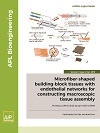
Cellular and Molecular Bioengineering
Scope & Guideline
Transforming Ideas into Solutions in Cellular Bioengineering
Introduction
Aims and Scopes
- Tissue Engineering and Regenerative Medicine:
Research exploring the development and application of biomaterials and scaffolds for the regeneration of tissues and organs, including the engineering of extracellular matrices and stem cell therapies. - Cellular Mechanotransduction:
Investigations into how cells sense and respond to mechanical stimuli, which plays a crucial role in various physiological and pathological processes. - Microfluidic and Organ-on-a-Chip Technologies:
Innovative designs and applications of microfluidic systems that simulate human organ functions, facilitating drug testing and disease modeling. - Synthetic Biology and Genetic Engineering:
Studies focused on the design of novel biological parts and systems, including the use of engineered proteins and genetic circuits for therapeutic applications. - Cancer Biology and Therapeutics:
Research on the cellular and molecular mechanisms underlying cancer progression and metastasis, along with the development of targeted therapies and drug delivery systems. - Extracellular Vesicles and Cell Communication:
Exploration of the role of extracellular vesicles in intercellular communication and their potential as therapeutic agents. - Biophysical Characterization of Cells:
Utilization of biophysical techniques to characterize cellular behavior, including studies on cell motility, adhesion, and mechanical properties.
Trending and Emerging
- Artificial Intelligence and Machine Learning Applications:
The integration of AI and machine learning techniques into bioengineering research is on the rise, particularly for data analysis, predictive modeling, and enhancing educational methodologies. - Advanced Biomaterials and Hydrogel Technologies:
There is a growing focus on the development of new biomaterials and hydrogels that mimic the extracellular matrix, enhancing tissue engineering applications and regenerative medicine. - Intercellular Communication Mechanisms:
Research on the role of extracellular vesicles and other forms of cell communication is increasingly important, highlighting their potential in therapeutic applications and disease modeling. - Personalized Medicine and Precision Therapies:
An emphasis on tailoring treatments based on individual patient profiles is emerging, particularly in cancer therapies and regenerative medicine, leveraging bioengineering innovations. - Tumor Microenvironment Studies:
There is a noticeable trend towards investigating the complex interactions within tumor microenvironments, utilizing novel in vitro models to better understand cancer biology and therapeutic resistance.
Declining or Waning
- Traditional In Vitro Models:
Research utilizing standard two-dimensional cell culture systems appears to be diminishing as the field moves toward more complex, physiologically relevant three-dimensional models. - Basic Cellular Mechanisms without Therapeutic Applications:
Studies focusing solely on fundamental cellular processes without direct applications to therapy or engineering solutions are becoming less prominent, as there is a growing emphasis on translational research. - Single-Cell Analysis Technologies:
Although still important, there seems to be a reduction in the number of publications solely dedicated to single-cell sequencing or profiling technologies, as these methods become more integrated into broader studies. - Animal Models for Drug Testing:
Research relying heavily on traditional animal models for drug testing is declining in favor of human-relevant models such as organ-on-a-chip systems.
Similar Journals

International Journal of Stem Cells
Elevating the Dialogue in Stem Cell ScienceThe International Journal of Stem Cells is a distinguished peer-reviewed journal dedicated to advancing the field of stem cell research. Published by the Korean Society for Stem Cell Research, this journal has established itself as a vital source of high-quality research since its inception in 2008. Operating under the ISSN 2005-3606 and E-ISSN 2005-5447, the journal caters to a global audience, featuring works that span a diverse array of topics within Cell Biology and Developmental Biology. It is noteworthy that as of 2023, the journal is ranked Q3 in Cell Biology and Q2 in Developmental Biology, highlighting its growing influence and credibility in the scientific community. Given its commitment to facilitating open scientific communication, it is crucial for researchers, professionals, and students to engage with the rigorous research published in this journal as it profoundly impacts the understanding and application of stem cell science. With accessibility to a wealth of innovative studies, the International Journal of Stem Cells remains an indispensable resource for anyone interested in the transformative potential of stem cell research.

CELL AND TISSUE RESEARCH
Fostering Excellence in Pathology and Forensic Medicine ResearchCELL AND TISSUE RESEARCH, published by Springer, is a premier journal dedicated to advancing the field of cell biology, histology, pathology, and forensic medicine. With a proud history dating back to its foundation in 1924 and continuing its legacy, this journal has established itself as a vital source for innovative research, facilitating the dissemination of significant findings that contribute to the understanding of cellular and tissue dynamics. Hailing from Germany, the journal exhibits an impressive standing in the academic community with a 2023 impact factor reflected in its category quartiles: Q2 in Cell Biology, Q1 in Histology, and Q1 in Pathology and Forensic Medicine. It ranks notably within multiple Scopus categories, including 32/208 in Pathology and Forensic Medicine and 13/62 in Histology, showcasing its high percentile rankings of 84th and 79th, respectively. Researchers, professionals, and students benefit from its extensive coverage and rigorous peer-review process that ensures the integrity and relevance of its published works, thus making it an essential resource in the scientific community. While it operates under a subscription model, its commitment to quality and impact makes it an indispensable journal for anyone engaged in cellular and tissue research.

Advanced Biology
Advancing Knowledge, Inspiring DiscoveriesAdvanced Biology, published by WILEY-V C H VERLAG GMBH, serves as a premier platform where innovative research and scientific breakthroughs in the fields of biochemistry, genetics, and molecular biology converge. Established in 2021, this journal has rapidly ascended to prominence, securing Q1 rankings in its primary categories, including general biochemistry and biomedical engineering, and a solid Q2 ranking in biomaterials. With an ISSN of 2701-0198 and an emphasis on open access, Advanced Biology ensures that rigorous peer-reviewed research is accessible to a global audience, enhancing visibility and fostering collaboration among researchers, professionals, and students alike. By 2024, it aims to continually elevate scientific understanding and innovation, catering to the growing interdisciplinary nature of these critical fields. With Scopus rankings placing it amongst the top quartiles in its disciplines, Advanced Biology is poised to make significant contributions to the future of life sciences.

APL Bioengineering
Connecting Minds, Elevating Bioengineering InnovationsAPL Bioengineering is a premier open-access journal published by AIP Publishing, dedicated to advancing the field of bioengineering and its interdisciplinary applications. Established in 2017, this journal serves as a vital platform for researchers, professionals, and students interested in the critical intersections of bioengineering, biomaterials, biomedical engineering, and biophysics. With an impressive impact factor and consistent rankings in the Q1 category across multiple domains, including biochemistry and materials science, APL Bioengineering has positioned itself among the top journals in its field. The journal aims to publish innovative original research, comprehensive reviews, and insightful case studies that further the understanding and application of bioengineering principles. Since its inception, APL Bioengineering has fostered a community of thought leaders, providing open access to ensure broad dissemination of knowledge and advancements that underpin the future of biomedical innovation.

EXPERIMENTAL CELL RESEARCH
Advancing Knowledge in Cellular MechanismsEXPERIMENTAL CELL RESEARCH is a highly respected journal published by Elsevier Inc, specializing in the dynamic and ever-evolving field of Cell Biology. With an impact factor positioned in the Q2 quartile for 2023, it ranks at the 124th position out of 285 in the Scopus Ranks, indicating a solid reputation among peers in the domains of biochemistry, genetics, and molecular biology. Since its inception in 1950, the journal has contributed significantly to the dissemination of groundbreaking research, providing a platform for studies that explore the nuances of cellular mechanisms, processes, and experimental methodologies. Although the journal currently does not offer open access, its commitment to high-quality, peer-reviewed research continues to attract submissions from leading scientists and scholars across the globe. Researchers, professionals, and students alike will find this journal an invaluable resource for keeping abreast of current developments and innovative breakthroughs in cellular science.

MOLECULAR AND CELLULAR BIOLOGY
Bridging Knowledge Gaps in Molecular BiologyMOLECULAR AND CELLULAR BIOLOGY, published by TAYLOR & FRANCIS INC, stands as a preeminent platform for researchers, professionals, and students engaged in the dynamic field of molecular and cellular biology. Established in 1981 and ongoing into 2024, the journal features cutting-edge research that spans across vital sub-disciplines, garnering a strong impact in its contributions to the scientific community. With an impressive Q2 ranking in Cell Biology and Q1 ranking in Molecular Biology for 2023, it consistently publishes high-quality articles that reflect the latest advancements and discoveries within the field. The journal is particularly well-regarded for its rigorous peer-review process and commitment to scientific excellence, making it an invaluable resource for those seeking to deepen their understanding of molecular mechanisms and cellular processes. Although not open access, the journal offers diverse access options for researchers to reach the latest findings. By maintaining a strong focus on biochemistry, genetics, and molecular biology, MOLECULAR AND CELLULAR BIOLOGY remains essential reading for anyone looking to contribute to or stay informed about significant developments within this pivotal area of study.

JOURNAL OF CELLULAR PHYSIOLOGY
Charting New Territories in Cell Biology and PhysiologyJOURNAL OF CELLULAR PHYSIOLOGY, published by Wiley, is a leading peer-reviewed journal that has been at the forefront of cellular research since its inception in 1945. With its prestigious Q1 and Q2 rankings in the fields of Clinical Biochemistry and Cell Biology, this journal is highly regarded within the scientific community, reflecting its significant impact factor and rigorous peer-review process. Addressing the intricacies of cell function and physiology, it serves as a crucial resource for researchers, professionals, and students dedicated to advancing knowledge in the life sciences. The journal publishes cutting-edge research articles, integral reviews, and significant findings that bridge basic biology and clinical applications, ensuring access to high-quality scholarly content that informs current practices and future research directions. Although not open access, the journal maintains a rich archive of studies, making it an essential reference point for those invested in the health and biological sciences.

Cell Communication and Signaling
Fostering Global Collaboration in Cellular ResearchCell Communication and Signaling is a premier peer-reviewed journal published by BMC that has made significant contributions to the fields of biochemistry, cell biology, and molecular biology since its establishment in 2003. As an open access journal, it offers unrestricted access to high-quality research, fostering collaboration and innovation among scientists around the globe. The journal is distinguished by its Q1 ranking in all three relevant categories for 2023, underscoring its critical role in advancing the understanding of cellular communication mechanisms and signaling pathways. Positioned within the United Kingdom, Cell Communication and Signaling has been an invaluable resource for researchers, professionals, and students alike, ensuring that the latest findings are accessible to a diverse range of audiences. With an impressive Scopus ranking—placing it in the top percentiles within its subject areas—this journal continues to set the standard for excellence in the pursuit of understanding complex cellular interactions.

Cell Regeneration
Exploring the Future of Regenerative BiologyCell Regeneration, published by SPRINGERNATURE, stands at the forefront of biological research, focusing on the dynamic field of cellular development and regenerative biology. Since its establishment in 2012, this journal has embraced an Open Access model, facilitating widespread dissemination of key findings and fostering collaboration among researchers in the Netherlands and beyond. With an impact factor underscoring its significance, Cell Regeneration is positioned in the Q2 category in both Cell Biology and Developmental Biology as of 2023, ranked #32 out of 82 and #170 out of 285 in relevant Scopus peer fields. The journal encompasses a broad spectrum of research that advances our understanding of cellular processes, offering vital insights into regenerative mechanisms and their applications in therapies. This robust platform not only serves as a valuable resource for researchers, professionals, and students but also encourages scholarly dialogue and innovation in the fast-evolving landscape of cell biology.

CELL RESEARCH
Illuminating the Pathways of Life SciencesCELL RESEARCH is a premier peer-reviewed journal dedicated to advancing the field of cell biology and molecular biology, published by SpringerNature. With an impressive impact factor and consistently ranking in the Q1 quartile for both cell biology and molecular biology, this journal serves as a pivotal resource for researchers, professionals, and students seeking to explore the latest discoveries and advancements in cellular mechanisms and their implications for health and disease. Since its inception in 1996, CELL RESEARCH has cultivated a distinguished reputation, currently boasting ranks in the top percentile of Scopus categories, reaffirming its influence and relevance to the scientific community. Although it is not an Open Access journal, its rigorous selection process ensures the publication of high-quality articles that contribute significantly to our understanding of life sciences. For those deeply engaged in the realms of biochemistry, genetics, and molecular biology, CELL RESEARCH is an essential conduit of innovative research and critical insights.